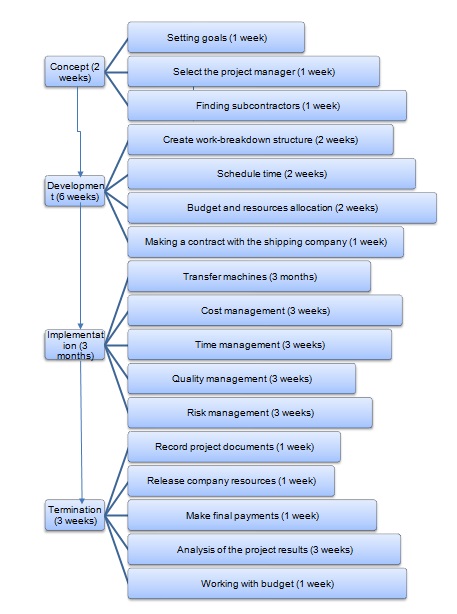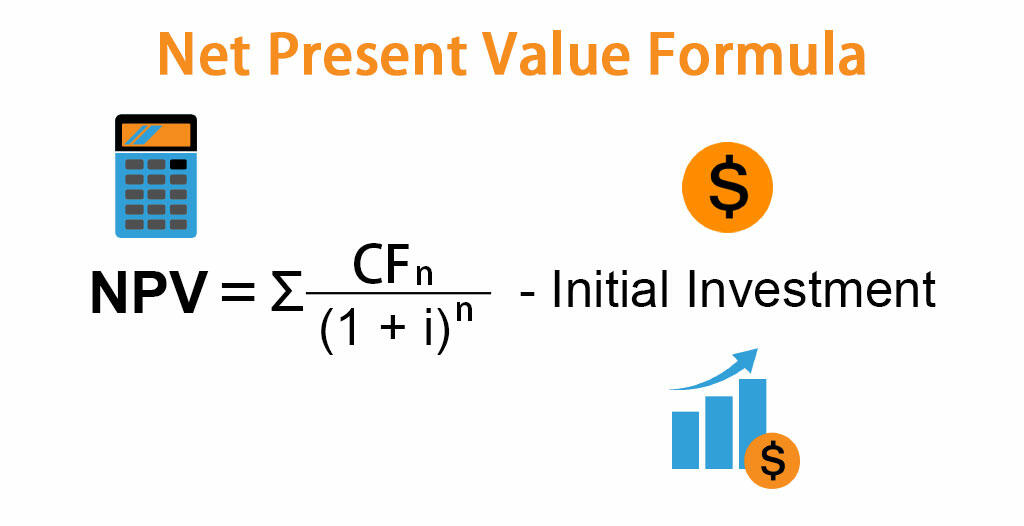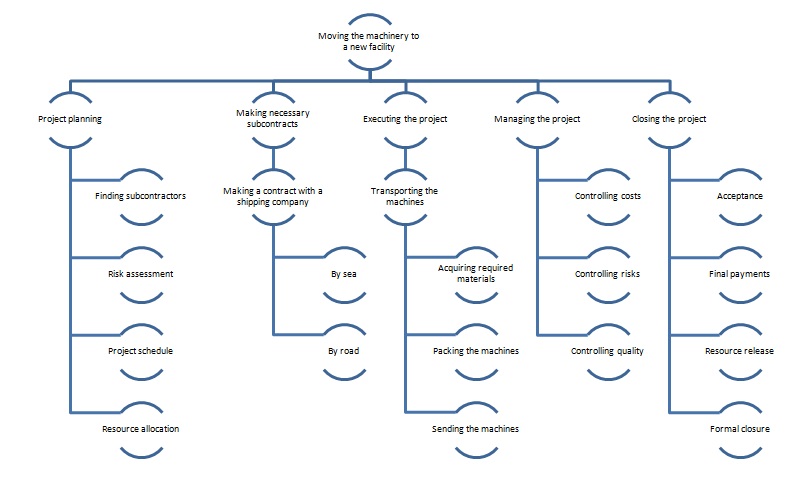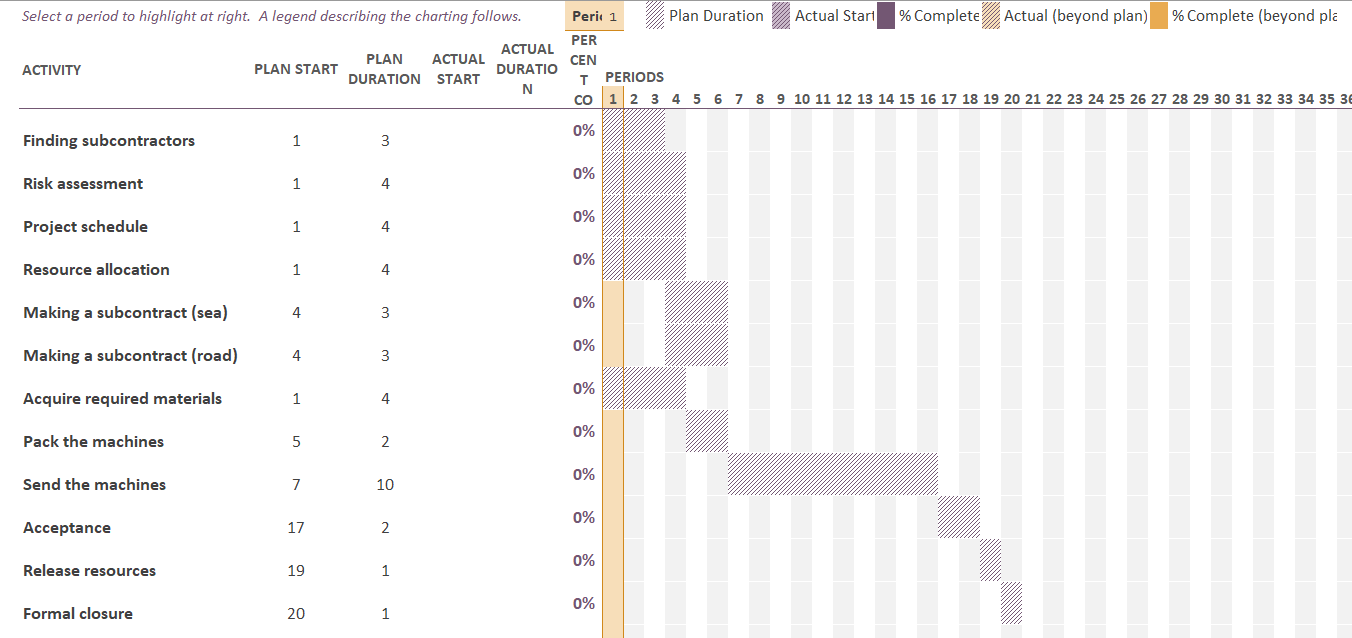General Aspects
Characteristics
Although every project is different, there are some characteristics that can be attributed to all of them. The Project Management Body of Knowledge (PMBOK) lists five commonalities of projects (Heagney, 2016). These characteristics are change, temporariness, cross-functionality, uniqueness and uncertainty. Change means that every project is targeted at making modifications to the current state of the company. If a venture is evaluated to not result in any significant changes, then it might not be wise to initiate this project (Binder, 2016).
All projects are temporary and have the start and end dates (Heldman, 2018). They require the collaboration of employees and managers from various departments. Every project is different from the previous because key elements such as the location, weather conditions and the experience of employees are always different. There is no guarantee that the project will succeed, even when much forecasting is done. These five characteristics are crucial because if they are not present in a project, it may be unsuccessful, fail to meet the deadline, not align with the company’s goals, or be impossible to implement.

Structure
The project starts once the project manager and the assistants visit the location and determine the required set of activities. The team will analyse the site, determine the most appropriate route to the area and identify any risks associated with the delivery. The project deals with only the transfer of assembly machines – activities related to the installation and testing are not within the scope of the project. The devices must be delivered to the new location within six months.
Possible adverse road conditions may pose a hindrance to the safe and fast delivery of the machines. The reason why the materials and machines should be moved in winter is that it will be easier for employees to start working at a new site in summer. Thus, it is crucial to finish transferring the machines before summer starts.
Network Diagram
A critical path is the longest path in the network diagram. In the current graph, the implementation phase takes the most extended amount of time. Therefore, this path is considered to be critical and plays a significant role in evaluating the total time needed to complete the project. The project will take six months to complete – several days are saved by accomplishing some tasks in parallel. The power of Gantt charts is fully realised when there are some tasks that can be done concurrently. Gantt diagrams make the process of managing such projects easier.
Net Present Value
Net Present Value (NPV) is the formula for evaluating the project’s profitability. It is considered to be the most accurate by the members of the business community (Harrison and Lock, 2017). It calculates the projected profits, but instead of merely subtracting the sum of initial investments, it first calculates the present value of the forecasted profits. This approach is appropriate because the investment is made today, but the benefits are gained over the course of several years in the future. The formula is presented below in detail.

Risks
Unexpected events can occur during any of the phases of the project. Therefore, the assessment should be done for each stage. For instance, transferring by ship has its own risks, such as the package being held by pirates, unexpected disasters or an accident on the ship. Ground shipping also has risks, such as an accident on the road, unfavourable weather conditions and the inappropriate quality of roads for safe transfer
Identifying such risks will allow the team to pack the machines appropriately and develop emergency plans. I would have managed the presented risks following several steps. First, I would outline possible threats associated with transferring by ship, ground shipping, incidents, and poor weather conditions. Then, I would evaluate the possibility of such threats to occur and discuss them with the employees responsible for the corresponding stages of the project. Finally, together with the team, I would create a plan for mitigating these risks.
Project Evaluation, Monitoring and Control
Because all projects incorporate some degree of uncertainty, project evaluation, monitoring and control are critical. These measures allow the project manager to track progress and determine whether any alterations should be made to the activities. If the project is consuming too many resources or is running behind schedule, the team should consider assessing the project to identify any deficiencies. Only by using this iterative approach, the project will have more chances to succeed. Therefore, the Concrete Masonry Corporation’s project should also employ these quality audits.
Introduction
Project management processes are the most critical factors of the project’s success. While the availability of resources and the necessary expertise in terms of human resources are essential, the inability to manage these resources inevitably leads to the project’s failure. This paper explores the Concrete Masonry Corporation’s venture of transferring its production machines to the facility overseas from the perspective of project management. All four phases of projects are described in the context of the given project.
Initiation (Concept)
The project management life cycle starts with the Initiation phase, which can also be considered the stage of Concept. Key objectives, purpose, scope and deliverables are determined and presented during this first step. Therefore, the Initiation step is crucial for setting the right goals and feasible objectives.
Also, the project manager is chosen during this phase (Fewings and Henjewele, 2019). Selecting the correct manager is critical because he or she will determine how the rest of the phases are carried out (Fewings and Henjewele, 2019). Appropriate knowledge and experience of a bright project manager can significantly influence the course of the project and may lead to cost savings, time savings and the overall success (Fewings and Henjewele, 2019).
Business Case
A business case is information that encompasses the reasons behind starting a project (Kerzner, 2017). It may take a variety of forms, such as a written document, an oral agreement or a presentation (Kerzner, 2017). In the context of the Concrete Masonry Corporation’s project, the business case is comprised of the necessity to increase competitiveness by reaching new geographical markets.
Moving part of the production out of the country where the company is headquartered will allow the enterprise to make significant adjustments to its supply-demand scale. Because the company currently operates only in one geographical market where the competition is fierce, a number of machines are kept in an idle state because of the low demand.
Project Scope Statement
The Concrete Masonry Corporation’s project only deals with the transfer of eight pre-stressed concrete assembly machines to a new facility in Eastern Europe. The project team assumes that it is possible to reach the destination country by sea and manage the rest of the route by the road. Therefore, the team also implies that there is a road network of adequate quality to move the machines to the facility safely. The major constraint is time because the devices should be ready to be operated on by September when the production is planned to launch.
Project Stakeholders
Because stakeholders directly impact the objectives, deliverables and the budget of the project, the manager should be in constant contact with these individuals (Eskerod and Jepsen, 2016). In the current case, the project affects the company as a whole. Therefore, all top managers are part of the stakeholder board – the CEO is the most important. The list also includes the finance manager, supply manager and legal experts in the company. The company is to launch a production facility in a foreign country. Therefore, the knowledge and assistance of a legal expert are essential in order to move the machines across the border seamlessly.
Planning (Development)
Traditional belief states that planning is half of the success of any venture. In project management, the second phase is Planning or Development and its significance is notable (Kerzner, 2018). This second step in the life cycle takes the central role because it consolidates the objectives obtained from the Initiation phase and documents how these goals will be reached in the subsequent stages (Lock, 2017).
The primary elements of this phase are the work-breakdown structure, time schedule, budget and resource allocation (Marchewka, 2016). The project team should also identify any risks that may occur during the project and document the proposed methods of overcoming these potential challenges.
Project Priorities
The board and the project team emphasise the importance of safely delivering the machines. Upon reaching the destination, the devices must be able to operate with no disruptions. Therefore, any physical damage is not acceptable. Another critical item is the time of delivery – moving the machines in at least a month before the production process launch is critical. There can be no delays in the production process launch because the company is already losing the competition to other major rivals. The team must also meet the maximum amount of available funds of 900,000 pounds. The board labels all elements of the priority matrix as critical.
Outlining Deliverables
Deliverables are any tangible or non-tangible goods or services that are expected to be obtained when the project is finished (Meredith, Mantel and Shafer, 2017). However, in the context of the given project, the primary deliverable is the state of the company in which it is able to use its pre-pressed concrete assembly machines to manufacture the final commodities. The project contains several milestones that also produce deliverables that directly impact the success of subsequent stages (Meredith, Mantel and Shafer, 2017). For instance, a preliminary customs declaration is necessary before the shipment may be dispatched abroad.
Budget Estimation
Estimating costs allows the stakeholders and the project team to see whether the project is feasible (Nicholas and Steyn, 2017). The budget is comprised of direct costs and indirect costs (Nicholas and Steyn, 2017). Directs costs are salaries paid to the project employees, materials and supplies required to execute the project, expenditure for travel needs and subcontracts (Nicholas and Steyn, 2017).
The given project has a project manager and five part-time assistants. Because the team members are full-time employees in the company, no additional spending is required because their payment is not directly related to the project and is the concern of their respective departments. Travel is needed, so that team members get acquainted with the final destination of the machinery. The packaging of the devices requires special materials that should be bought. Also, the company has to make contracts with several logistics companies to deliver the machines to the destination country by sea and to take the rest of the route by road.
Work Breakdown
The work-breakdown structure (WBS) is a deliverable that organises the activities of the project team into manageable portions (Nicholas and Steyn, 2017). It decomposes the work and provides a hierarchy of actions (Nicholas and Steyn, 2017). The project team should carefully design this document because this deliverable is important for developing an accurate project schedule (Nicholas and Steyn, 2017). WBS also impacts the efficiency of resource usage and the actual time needed to accomplish the project (Nicholas and Steyn, 2017). Figure below contains the WBS for the Concrete Masonry Corporation’s project.

Project Schedule
The project team must develop a project schedule in order to control the activities and see whether they are meeting the deadline requirements (Harrison and Lock, 2017). The elements of the schedule include activities, milestones and deliverables (Harrison and Lock, 2017). They may closely resemble the items from the WBS because the schedule is often created on the basis of WBS and other listings (Harrison and Lock, 2017). Figure below contains a Gantt chart for the given project.

Risk Assessment
Because all projects incorporate some level of uncertainty, it is crucial to identify any risks that may pose a hindrance to the success of the project (Turner, 2016). The project manager, the team and stakeholders should conduct a risk assessment to prepare for unexpected events beforehand (Schwalbe, 2015).
The typical process of risk assessment contains risk identification, risk categorisation and grouping, assigning a probability and determining the potential impact of each risk and developing a risk response (Walker, 2015). For the given project, potential risks are ship wreckage, road accident, theft and problems with customs. The team is responsible for documenting all these risks and developing a thorough response plan.
Implementation
The implementation phase is comprised of the activities that implement all the planned events and actions (Harrison and Lock, 2017). The outcome of this phase is the primary objective of the project and the reason behind the initiation of this venture (Harrison and Lock, 2017). It is the most complex stage in the project management life cycle because the project manager and his or her team often must make hard decisions and quickly respond to changing environments (Harrison and Lock, 2017).
Because of the constant change in the environment, not everything happens according to the project plan. Therefore, the project manager has to be the most active participant during this step, managing time and costs, controlling the quality and responding to adverse events.
Time Management
Time is the most important resource of all human beings and is the most critical constraint of almost any project (Harrison and Lock, 2017). This statement is also applicable to the given project (Harrison and Lock, 2017). Therefore, time management should be a significant activity done by the project manager (Harrison and Lock, 2017).
This activity includes continuously checking the project schedule to identify any delays. If there are any inconsistencies, the manager has to work to identify the source of the issue and propose a timely solution for the challenge (Harrison and Lock, 2017). The solution may be to reassign tasks between different people or, in the case when the matter involves a third party, to directly intervene.
Cost Management
Cost management occurs both during the planning phase and during the project’s execution (Harrison and Lock, 2017). While there is only a limited chance to provide any interventions to reduce costs as the project is being executed, cost management is still critical (Harrison and Lock, 2017). The activities include documenting the actual costs and tracking them in the cost management plan developed during the previous stage.
If there are severe deviations, the project manager has to intervene immediately to identify the issues (Harrison and Lock, 2017). When the project is completed, and the deliverables are obtained, this knowledge can be used to compare with the forecasted costs in order to enhance future project budgets and cost management plans.
Quality Management
Quality is a necessary component of any project deliverable and should be considered during the planning phase. However, while the planning phase does everything to meet the quality requirements, only in the execution phase do the activities provide a portrayal of the actual quality (Harrison and Lock, 2017). For instance, the company may expect that it receives the best service from the most famous shipping company. However, the project manager should be actively involved in the quality control to check whether the subcontractors are meeting the quality requirements. The project manager should also demand high standards from the team.
Risk Management
The document obtained from risk assessment during the planning phase should be regularly updated to reflect the latest information and environment. Therefore, risk management activities should be performed by the project manager and his or her team during the execution phase (Harrison and Lock, 2017). As the project progresses, risks that were attributed to operations already completed should be checked off. Any new threats that emerge from other unexpected events should be immediately documented, and the appropriate response strategies should be developed. For instance, if massive protests start occurring in the destination country, then there are risks such as road blockings, sabotage and raids.
Termination
The Termination is the final phase of the project and occurs after the primary deliverable of the project is obtained. The main objective of this phase is to record all related project documents, release unused company resources so that they can be used in other ventures, obtaining formal acceptance, making final payments and closing the project (Harrison and Lock, 2017). A project is not only an opportunity to gain financial benefits but also to gain experience. Therefore, for a company to thrive in the future and not repeat its previous mistakes, the project team should provide detailed documentation on the errors and the lessons learned for the venture.
Analysis of the Project Results
The project outcomes should be carefully analysed by the project management team to acquire any beneficial knowledge that can be used in the future. The project manager has to compare the project plan with the actual results. This comparison will allow the company to construct more accurate cost estimates, project schedules and work-breakdowns (Harrison and Lock, 2017). For the analysis to be complete, all information should be documented during the previous phases. For instance, when there was a change in schedule, and it was not reflected in the schedule file, the company may lose vital information regarding the causes of modification and interruption.
Documenting Project Closure
The project is not closed until the results pass the acceptance test and the appropriate papers are signed. Therefore, the project management team has to demonstrate that the work done by the team adheres to all quality requirements and is done within the constraints set by the company (Harrison and Lock, 2017). Damage of the equipment, for instance, may pose a hindrance to successful project closure. In other cases, stakeholders may not agree with some project intricacies. In such circumstances, the project manager should take an active role and explain why a particular decision was made or why the schedule was altered during the execution phase.
Accounting Used and Unused Budget
Not all projects use all the available resources to a full extent. There are situations where the project team is able to cut costs by making more beneficial decisions (Harrison and Lock, 2017). In other cases, the available budget may be not enough, and the team may attract extra funding. In either case, the project team has to provide a full breakdown of costs and explain what items make up the final cost of the project and why (Harrison and Lock, 2017).
This information will be used by the company to make more accurate forecasts and develop reliable project budgets in the future (Harrison and Lock, 2017). This activity is significantly influenced by the quality of work done by the project manager when controlling costs during the execution phase.
Reference List
Binder, J. (2016) Global project management: communication, collaboration and management across borders. New York, NY: Routledge.
Educba. (2020) Net Present Value formula. Web.
Eskerod, P. and Jepsen, A. L. (2016) Project stakeholder management. New York, NY: Routledge.
Fewings, P. and Henjewele, C. (2019) Construction project management: an integrated approach. New York, NY: Routledge.
Harrison, F. and Lock, D. (2017) Advanced project management: a structured approach. New York, NY: Routledge.
Heagney, J. (2016) Fundamentals of project management. New York, NY: Amacom.
Heldman, K. (2018) Project management jumpstart. New York, NY: John Wiley and Sons.
Kerzner, H. (2017) Project management: a systems approach to planning, scheduling, and controlling. New York, NY: John Wiley and Sons.
Kerzner, H. (2018) Project management best practices: achieving global excellence. New York, NY: John Wiley and Sons.
Lock, D. (2017) The essentials of project management. New York, NY: Routledge.
Marchewka, J. T. (2016) Information technology project management: providing measurable organizational value. New York, NY: John Wiley and Sons.
Meredith, J.R., Mantel Jr, S.J. and Shafer, S.M. (2017) Project management: a managerial approach. New York, NY: John Wiley and Sons.
Nicholas, J. M. and Steyn, H. (2017) Project management for engineering, business and technology. New York, NY: Routledge.
Schwalbe, K. (2015) Information technology project management. Boston, MA: Cengage Learning.
Turner, R. (2016) Gower handbook of project management. New York, NY: Routledge.
Walker, A. (2015) Project management in construction. New York, NY: John Wiley and Sons.